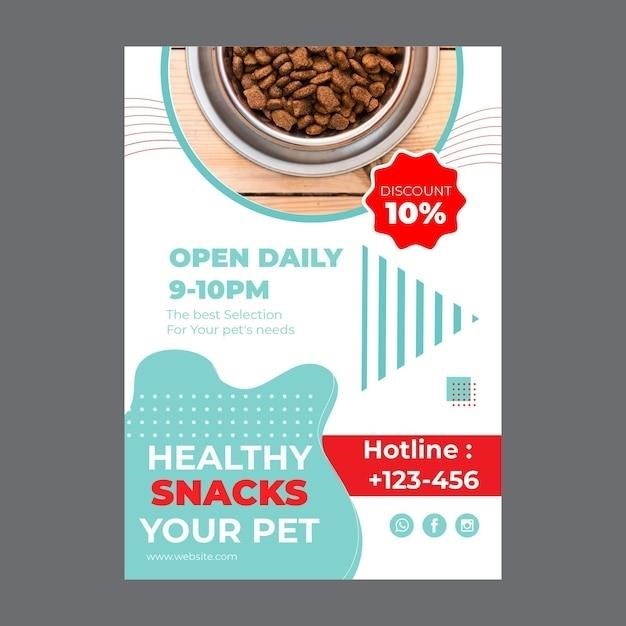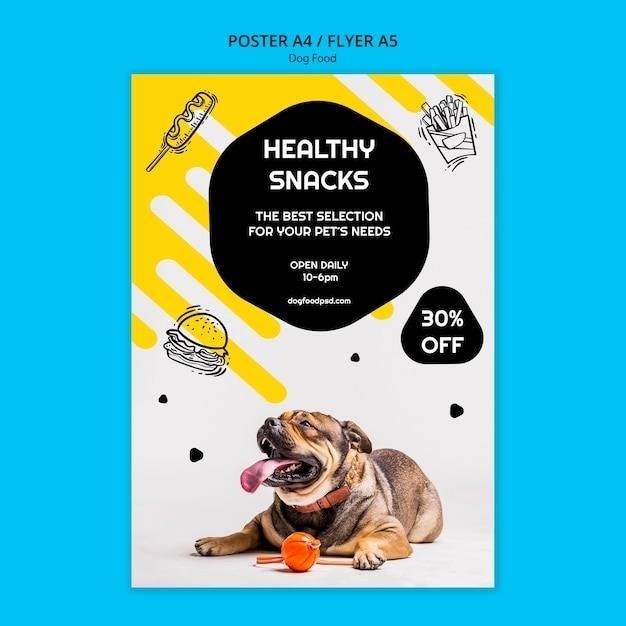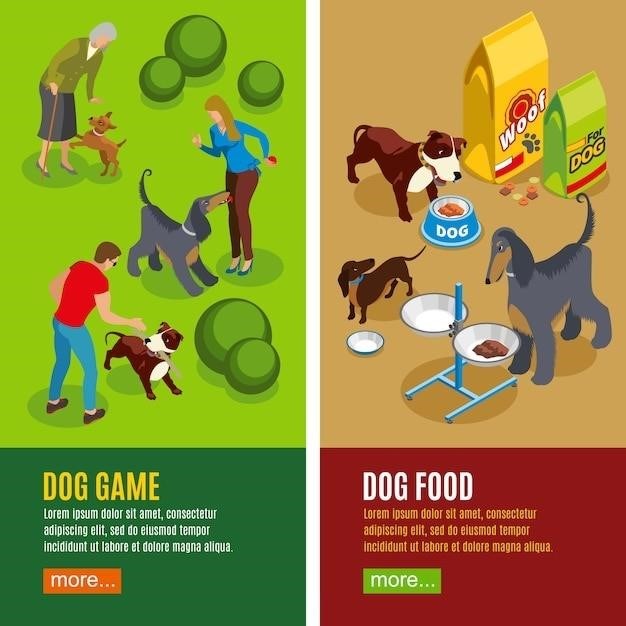Toxic Foods for Dogs⁚ A Comprehensive Guide
This guide provides a comprehensive overview of toxic foods for dogs, helping pet owners understand the risks and dangers of common household items that can harm their furry friends. Learn about the most common toxic foods, their potential effects, and what to do if your dog ingests something harmful. This guide also includes a printable list of toxic foods for dogs that you can keep handy in your kitchen or share with friends and family who may be caring for your dog.
Introduction
Dogs are curious creatures, often tempted by the delicious smells and tastes of human food. While sharing a snack with your furry friend might seem harmless, many common foods can be toxic or even deadly to dogs. It’s crucial for pet owners to be aware of these dangers and to ensure their canine companions only consume safe and appropriate treats. This comprehensive guide will equip you with the knowledge you need to keep your dog safe from the perils of toxic foods. We’ll delve into the most common toxic foods for dogs, explore the reasons why they are dangerous, and provide practical advice on how to prevent accidental ingestion. This guide also includes a downloadable PDF list of toxic foods to keep readily available for reference.
Why is it Important to Know Toxic Foods for Dogs?
Understanding which foods are toxic to dogs is essential for their health and safety. Many common human foods contain substances that can cause various health problems, ranging from mild gastrointestinal upset to severe organ damage and even death. It’s important to remember that even seemingly harmless foods like grapes or onions can be extremely dangerous for dogs. By being informed about the potential dangers, you can take proactive steps to protect your canine companion from accidental poisoning. This knowledge will enable you to make informed choices about what you feed your dog and to identify potential risks in your home and surroundings. Additionally, knowing which foods to avoid will help you respond quickly and appropriately if your dog does ingest something toxic.
Common Toxic Foods for Dogs
Several everyday foods that we enjoy can be toxic to our canine companions. It’s crucial to be aware of these common culprits to ensure your dog’s safety. Chocolate, a beloved treat for many, is particularly dangerous for dogs. Theobromine, a compound found in chocolate, can cause a variety of symptoms, including vomiting, diarrhea, hyperactivity, increased thirst, tremors, seizures, and even death. Grapes and raisins, despite their seemingly harmless nature, can cause kidney failure in dogs. The exact toxic substance is unknown, but even small amounts can be detrimental. Onions and garlic, whether raw, cooked, or powdered, contain compounds that can damage red blood cells, leading to anemia. Xylitol, a sugar substitute found in many sugar-free products, is extremely toxic to dogs, causing a rapid drop in blood sugar and potentially liver failure. Alcohol, in any form, can be lethal to dogs and should be kept out of reach at all times.

Chocolate
Chocolate, a beloved treat for many, is particularly dangerous for dogs. Theobromine, a compound found in chocolate, is a stimulant that dogs cannot metabolize as efficiently as humans. This can lead to a buildup of theobromine in their system, causing a range of symptoms, including vomiting, diarrhea, hyperactivity, increased thirst, tremors, seizures, and even death. The severity of the reaction depends on the type of chocolate consumed, the amount ingested, and the size of the dog. Dark chocolate and baking chocolate contain the highest levels of theobromine, making them the most dangerous. Milk chocolate is less toxic, and white chocolate contains almost no theobromine. If you suspect your dog has ingested chocolate, contact your veterinarian immediately.
Grapes and Raisins
Grapes and raisins, seemingly harmless treats for humans, pose a significant threat to dogs. While the exact toxic substance in these fruits remains unknown, they can cause acute kidney failure in dogs. Even a small amount of grapes or raisins can be enough to trigger this serious condition. Symptoms of grape or raisin toxicity can include vomiting, diarrhea, lethargy, loss of appetite, abdominal pain, increased thirst, and increased urination. If your dog has ingested grapes or raisins, it’s crucial to contact your veterinarian immediately. Early intervention can improve the chances of recovery.
Onions and Garlic
Onions and garlic, staples in many kitchens, are highly toxic to dogs. These vegetables contain a compound called thiosulphate that can damage red blood cells, leading to a condition called hemolytic anemia. This condition can cause weakness, lethargy, pale gums, rapid breathing, and even death. The toxicity of onions and garlic applies to all forms, whether raw, cooked, powdered, or in dehydrated form. Even small amounts of onion or garlic can be harmful to dogs, so it’s essential to keep them out of reach. If you suspect your dog has ingested onions or garlic, contact your veterinarian immediately.
Xylitol
Xylitol, a popular sugar substitute found in many sugar-free products like gum, candy, and baked goods, poses a serious threat to dogs. Even small amounts of xylitol can cause a rapid drop in blood sugar levels, leading to liver failure and potentially death. Xylitol is quickly absorbed into the bloodstream, and symptoms can appear within 30 minutes of ingestion. Signs of xylitol poisoning in dogs include vomiting, lethargy, weakness, loss of coordination, and seizures. If you suspect your dog has ingested xylitol, immediate veterinary attention is crucial. Keep all products containing xylitol out of reach of your dog and carefully check ingredient labels of all food items.
Alcohol

Just like humans, dogs are highly susceptible to the toxic effects of alcohol. Even small amounts of alcohol can cause serious health problems, and larger quantities can be fatal. The symptoms of alcohol poisoning in dogs include vomiting, diarrhea, difficulty breathing, loss of coordination, tremors, and coma. Alcohol can also lead to liver damage and other long-term health issues. It is crucial to keep all alcoholic beverages out of reach of your dog. If you suspect your dog has ingested alcohol, contact your veterinarian immediately for guidance and potentially emergency treatment.
Other Toxic Foods
While the foods mentioned earlier are among the most commonly known toxic foods for dogs, there are many other items that can pose a risk to your pet’s health. Some examples include avocado, macadamia nuts, mushrooms, sugar-free foods containing xylitol, and nutmeg. Avocado contains a substance called persin that can cause vomiting and diarrhea in dogs. Macadamia nuts can lead to weakness, tremors, and vomiting. Mushrooms can contain toxins that can cause liver and kidney damage. Xylitol, a common sugar substitute, is highly toxic to dogs and can cause a rapid drop in blood sugar levels, liver failure, and even death. Nutmeg can cause tremors, seizures, and central nervous system damage. It’s crucial to keep these foods away from your dog, as even small amounts can cause serious health problems. Always consult with your veterinarian if you have any concerns about your dog’s diet or if you suspect they may have ingested a toxic substance.
Avocado
Avocado, while a popular fruit for humans, can be toxic to dogs due to a substance called persin. Although the flesh of the avocado is not as dangerous, the pit and peel contain high concentrations of persin and should be avoided. Ingestion of avocado can cause vomiting, diarrhea, and in some cases, even more serious health complications. The toxicity of avocado can vary depending on the dog’s size and the amount consumed. It’s best to keep avocados out of reach of your dog and to avoid feeding them any part of the fruit, including the skin, pit, and leaves. If you suspect your dog has eaten avocado, contact your veterinarian immediately.
Macadamia Nuts
Macadamia nuts are a popular snack for humans, but they can be toxic to dogs. The exact toxic compound in macadamia nuts is unknown, but they can cause a range of symptoms, including weakness, tremors, vomiting, and even paralysis. The severity of the symptoms depends on the amount of macadamia nuts consumed and the size of the dog. Even a small amount of macadamia nuts can cause problems for a small dog. If you suspect your dog has eaten macadamia nuts, it’s important to contact your veterinarian immediately. They may recommend inducing vomiting or providing supportive care. It’s best to avoid feeding macadamia nuts to your dog altogether.
Mushrooms
Mushrooms are a common ingredient in many human foods, but they can be toxic to dogs. While some mushrooms are safe for humans to eat, many are toxic to dogs. The toxic compounds in mushrooms can cause a range of symptoms, including vomiting, diarrhea, tremors, seizures, and even death. If you suspect your dog has eaten mushrooms, it’s important to contact your veterinarian immediately. They may recommend inducing vomiting or providing supportive care. It’s best to avoid feeding mushrooms to your dog altogether. If you’re unsure whether a particular mushroom is safe for dogs, it’s best to err on the side of caution and avoid it.
Sugar-Free Foods
Sugar-free foods, often marketed as healthy alternatives, can be incredibly dangerous for dogs. The culprit is xylitol, an artificial sweetener commonly found in sugar-free gum, candy, baked goods, and even some medications. Xylitol is highly toxic to dogs, causing a rapid drop in blood sugar levels, leading to potentially fatal liver failure. Symptoms of xylitol poisoning can appear within 30 minutes of ingestion, including vomiting, lethargy, weakness, and seizures. If your dog has consumed sugar-free products, immediate veterinary attention is crucial. Always check the ingredient list of any human food before sharing it with your dog, and keep all sugar-free products out of reach.
Nutmeg
While nutmeg is a popular spice in human cuisine, it can be harmful to dogs. The active compound in nutmeg, myristicin, is a neurotoxin that can cause tremors, seizures, and central nervous system damage in dogs. Even small amounts of nutmeg can be dangerous, especially for smaller breeds; Symptoms of nutmeg poisoning can include disorientation, increased thirst, diarrhea, and rapid heartbeat. If you suspect your dog has ingested nutmeg, contact your veterinarian immediately. It is best to avoid giving your dog any food that contains nutmeg, even in small quantities, to ensure their safety.
Symptoms of Food Poisoning in Dogs
Recognizing the signs of food poisoning in dogs is crucial for prompt action. Symptoms can vary depending on the toxic substance ingested and the dog’s individual sensitivity. Common signs include vomiting, diarrhea, abdominal pain, excessive drooling, lethargy, loss of appetite, and tremors. In more severe cases, dogs may experience difficulty breathing, seizures, or even coma. If you notice any of these symptoms after your dog has consumed a potentially toxic food, it’s imperative to contact your veterinarian immediately. Early intervention can significantly improve the chances of a full recovery.
What to Do If Your Dog Eats a Toxic Food
Acting quickly is essential if you suspect your dog has consumed a toxic food. First, try to determine what your dog ate and how much. If possible, keep the packaging or a sample of the food for reference. Next, contact your veterinarian or the ASPCA Animal Poison Control Center (APCC) at (888) 426-4435. They can provide guidance on the specific situation and recommend the best course of action. In some cases, they may advise inducing vomiting, but this should only be done under their direction as it can be dangerous in certain situations. Be prepared to provide details about your dog’s breed, age, weight, and any pre-existing health conditions. Follow your veterinarian’s instructions carefully and monitor your dog closely for any signs of distress.
Keeping your dog safe and healthy requires a proactive approach to food safety. By being aware of the foods that are toxic to dogs, you can prevent potential health issues and ensure a long and happy life for your furry companion. Remember, it’s always best to err on the side of caution and avoid feeding your dog any foods that are not specifically designed for canine consumption. Consulting with your veterinarian is crucial for any questions or concerns regarding your dog’s diet, as they can provide personalized advice based on your dog’s individual needs and health history. By taking these steps, you can help keep your dog safe and enjoy a strong bond for years to come.
